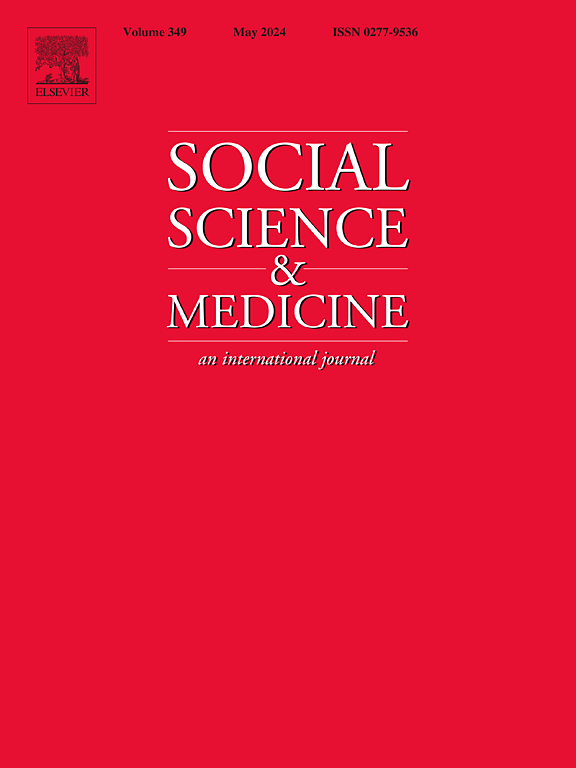Correlates of longitudinal patterns of racial discrimination in midlife and older Black adults: Evidence from the health and retirement study
IF 4.9
2区 医学
Q1 PUBLIC, ENVIRONMENTAL & OCCUPATIONAL HEALTH
引用次数: 0
Abstract
Objective
Single cross-sectional discrimination measures may mask dynamic patterns of cumulative experiences and exposure to racial discrimination. However, there is a dearth of studies assessing trajectories of racial discrimination, particularly among midlife and older Black adults in the United States. The study aims to identify trajectories of racial discrimination over 12 years. We also examine the association between sociodemographic characteristics and resilience resources with racial discrimination trajectories.
Methods
Using data from the Health and Retirement Study (2006–2020), repeated measures latent profile analysis was employed to identify racial discrimination trajectories among Blacks aged 50+ (N = 1710). Multinomial logistic regression examined the association between sociodemographic and resilience resources with racial discrimination trajectories.
Results
Three racial discrimination trajectories were identified: low-stable (70 %), moderate (23 %), and persistently high and increasing (7 %). Individuals reporting higher levels of major lifetime experiences of discrimination and greater neighborhood social cohesion were associated with membership in the “moderate” and the “persistently high and increasing” racial discrimination trajectory groups. Those reporting positive social support and psychological resilience were less likely to be in the “moderate” or the “persistently high and increasing trajectory” groups.
Conclusions
These findings suggest heterogeneity in the cumulative patterning of racial discrimination among midlife and older Black adults. Racial discrimination trajectories may enable greater precision in estimating the health consequences of cumulative exposure to discrimination. Future studies are warranted to determine whether membership in specific discrimination trajectory groups confers differential risk to age-related conditions.
中年和老年黑人种族歧视纵向模式的相关性:来自健康和退休研究的证据
目的单一的横截面歧视措施可能掩盖了累积经验和暴露于种族歧视的动态模式。然而,缺乏评估种族歧视轨迹的研究,特别是在美国的中年和老年黑人成年人中。这项研究旨在确定12年来种族歧视的轨迹。我们还研究了社会人口学特征和弹性资源与种族歧视轨迹之间的关系。方法利用健康与退休研究(2006-2020)的数据,采用重复测量潜在特征分析来识别50岁以上黑人(N = 1710)的种族歧视轨迹。多项逻辑回归检验了社会人口学和弹性资源与种族歧视轨迹之间的关系。结果发现三种种族歧视轨迹:低稳定(70%)、中等(23%)和持续高且不断增加(7%)。个人报告较高水平的主要终生歧视经历和更大的社区社会凝聚力与“中等”和“持续高且不断增加”的种族歧视轨迹组的成员资格有关。那些报告积极的社会支持和心理弹性的人不太可能处于“中等”或“持续高且不断增加的轨迹”组。结论:这些发现表明,在中年和老年黑人中,种族歧视的累积模式存在异质性。种族歧视的轨迹可以更精确地估计累积遭受歧视的健康后果。未来的研究有必要确定特定歧视轨迹组的成员资格是否会导致与年龄相关的疾病的不同风险。
本文章由计算机程序翻译,如有差异,请以英文原文为准。
求助全文
约1分钟内获得全文
求助全文
来源期刊

Social Science & Medicine
PUBLIC, ENVIRONMENTAL & OCCUPATIONAL HEALTH-
CiteScore
9.10
自引率
5.60%
发文量
762
审稿时长
38 days
期刊介绍:
Social Science & Medicine provides an international and interdisciplinary forum for the dissemination of social science research on health. We publish original research articles (both empirical and theoretical), reviews, position papers and commentaries on health issues, to inform current research, policy and practice in all areas of common interest to social scientists, health practitioners, and policy makers. The journal publishes material relevant to any aspect of health from a wide range of social science disciplines (anthropology, economics, epidemiology, geography, policy, psychology, and sociology), and material relevant to the social sciences from any of the professions concerned with physical and mental health, health care, clinical practice, and health policy and organization. We encourage material which is of general interest to an international readership.
 求助内容:
求助内容: 应助结果提醒方式:
应助结果提醒方式:


